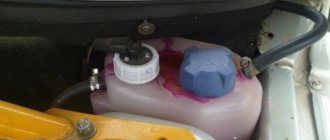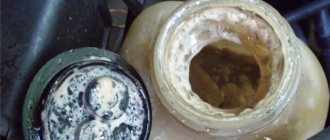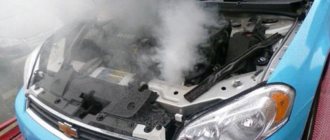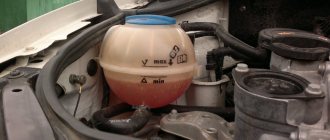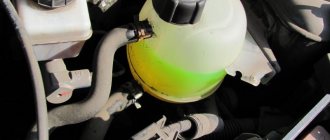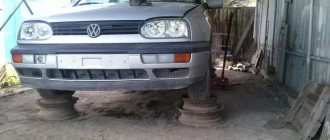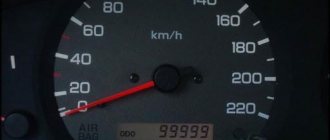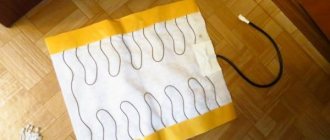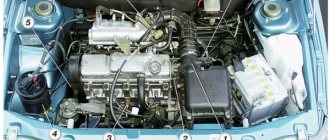The correct operation of internal combustion engines of modern cars directly depends on their constant cooling. For this, an air and liquid system is used, the latter of which operates through the circulation of antifreeze.
In this way, it is possible to keep the heating temperature of the internal combustion engine within 90 degrees Celsius. In some cases, due to one reason or another, the coolant begins to boil, resulting in leaks.
In order to prevent this from happening, it is important to understand why gases appear in the expansion tank of a vehicle and how you can deal with it.
First of all
Try replacing the cover with a new one or using a known working one for the duration of the test.
Notice how much the tank swells. If it is not significant and it is clear that it is not due to excess pressure, and you are the owner of a VAZ 2110-12, then you should not worry too much, since this is considered the norm for such cars.
The fact is that new tanks for such cars have a finless design and are made of plastic, which does not hold its shape very well, so over time they begin to swell.
Expansion tanks from Lanos, Priora, Nexia have proven themselves well; they are often installed instead of VAZ ones.
If the tank swells strongly and ruptures, even after replacing it along with the lid, then pay attention to the following points:
- Does the coolant boil?
- What color is the oil in the engine crankcase?
- Are there gases from the combustion chamber in the tank?
- What is the pressure in the cooling system;
- The quality of the tank itself.
Why does the cylinder head gasket break?
In most cases, the reason why problems arise with the cylinder head gasket is simple overheating . Because of it, the block cover may “lead”, and the plane along which the gasket adheres to two contacting surfaces will be disrupted. As a result, depressurization of the internal cavity occurs with all the ensuing consequences. It is mainly aluminum heads that change their geometry. Cast iron is not subject to such malfunctions; they are more likely to crack than to bend, and only in the most extreme cases.
Scheme for pulling cylinder head bolts on VAZ “classics”
Also, due to overheating, the gasket can heat up to temperatures at which it changes its geometry. Naturally, in this case depressurization will also occur. This is especially true for iron-asbestos gaskets.
Another reason is a violation of the bolt tightening torque . Both very large and small torque values have a detrimental effect. In the first case, the gasket may collapse, especially if it is made of low-quality materials. And in the second, exhaust gases pass out without obstructing them. In this case, gases together with atmospheric air will have a detrimental effect on the gasket material, gradually destroying it. Ideally, the bolts should be tightened using a dynamometer that shows the torque value; in addition, the sequence of their tightening should be observed. Help information about this can be found in the manual.
Gases in the expansion tank
The presence of gases in the expansion tank indicates that the cylinder head gasket has burned out, all signs of this problem. This is one of the main reasons why it can become bloated.
Burnout of the gasket could occur due to overheating of the engine, unless, of course, the time for its overhaul has arrived, since it is at 150 - 250 thousand km. mileage the service life of this gasket is calculated.
But there is an important point here - the reservoir will not expand if the valve in the roof is working properly, since excess pressure will still be released, but the engine will overheat. But, if the flow of gases is very strong, then the valve will not have time to release the pressure and the tank will eventually swell and even rupture.
In order to detect the presence of gases in the cooling system, you must:
- Visually inspect the coolant in the barrel with the engine running and make sure there are bubbles or not. If there are bubbles, then the gasket is most likely broken.
- A more accurate method is to use a gas analyzer. The device will accurately indicate the presence of gases.
- Use balloons or similar (well, you get the idea). The ball is placed on the neck of the tank and tied tightly with threads. You need to start the engine when it is cold, before the heated coolant begins to expand greatly. If the product inflates quickly, it means that exhaust gases are entering the cooling system, this is only possible through the cylinder head gasket.
- Check engine compression. If the car's mileage is not very high, then the compression should be normal, since the cylinder-piston group has not yet worn out. But if the cylinder head gasket is broken, the compression meter will show readings below normal.
You can also check in the area of which cylinder the gasket is broken. To do this, you need to supply air under pressure into the cylinder through the spark plug hole, while the tank cap must be removed.
If the cylinder head gasket is broken, bubbles will be visible in the tanks and air hissing.
The pressure in the cooling system is checked using a 3 atmosphere pressure gauge. To do this, you need to make a tee and connect the device to it.
Start the car and observe the readings. Readings of more than 1.5 atmospheres should already be alarming; 2 – not every barrel can withstand it.
Consequences of boiling
What happens if the car engine boils? The consequences of engine overheating can be the most tragic for a car.
There are several degrees of engine overheating that occur as a result of boiling liquid:
- slight overheating of the motor;
- average engine overheating;
- severe overheating of the motor.
Slight overheating. If the overheating of the engine as a result of antifreeze boiling does not exceed 10 minutes, then the car owner can be said to be very lucky. This may occur if the fan or thermostat fails. If you notice the engine overheating in time (according to the temperature sensor on the instrument panel), then you should turn off the car as quickly as possible. In this situation, the worst thing would be if the engine pistons start to melt.
But this is not scary, especially for owners of new cars. As a rule, in new cars the consequences of such overheating will not be noticeable. You need to start panicking and take your car for repairs if you clearly see smoke starting to appear from under the hood.
Refrigerant boiling in the expansion tank
Medium overheating occurs if the boiling time of the liquid exceeds 20 minutes. In this case, the driver may face the following consequences:
- cylinder heads may become bent;
- cracks may appear on the cylinder head;
- cylinder block gaskets will melt or burn out;
- destruction of the inter-ring partitions on the engine pistons;
- Engine oil will begin to flow through the seals.
The two stages of overheating described above often occur as a result of poor or inattentive vehicle maintenance. But severe engine overheating from boiling antifreeze can be a real “heart attack” for your car.
If “Tosol” boils and the engine is very overheated, then the consequences, as a rule, cover all parts of the engine. But this is not the saddest outcome of events. The worst thing that can happen is if the motor explodes as a result of overheating. But this rarely happens, since often the car system allows the driver to avoid such a decoupling - the engine components are destroyed at different rates, as a result of which it simply stalls. The so-called “wave of destruction” extends to the entire motor and other components surrounding it:
- the pistons begin to melt and burn;
- molten metal from the pistons drips onto the cylinder walls, as a result of which the movement of the piston becomes difficult. Accordingly, the piston quickly fails and becomes unusable;
- if the car does not stall due to broken pistons, problems with the engine fluid may begin;
- overheated motor fluid immediately loses its lubricating properties, as a result of which all rubbing parts gradually begin to fail;
- after this, melted elements begin to stick to the crankshaft, which also complicates its operation;
- when the valve seats fly out, the crankshaft simply breaks into several parts under the influence of the piston;
- after this, the piston can pierce one of the walls of the cylinder block, and this, in turn, leads to complete engine failure.
Coolant boiling
If antifreeze (antifreeze) boils, make sure:
- Does the radiator fan work and when does it turn on? The sensor may be faulty;
- Is the thermostat working? The coolant constantly moves in a small circle, thereby not cooling;
- Is the pump working?
- Is the cooling system, including the radiator, clogged?
- Is the system airy?
- Is the valve on the lid working properly? Low pressure in the system can cause premature boiling of the antifreeze.
As for airiness, for example, in VAZ 2110, 2111, 2112, from the experience of their operation, the system practically does not become airborne due to its special design.
In other cars, when replacing the coolant, an air lock may end up in the stove and, over time, make itself felt by overheating the engine and burning out the cylinder head gasket. It is important to monitor the instrument readings.
Thermostat malfunction
Under normal operating conditions, the thermostat must open fully to ensure an uninterrupted flow of coolant. They must also close to allow the antifreeze to heat up quickly during cold engine starting conditions. If the thermostat mechanism gets stuck in the open or closed position, then this will lead to overcooling or overheating, respectively. A faulty thermostat may open and close spontaneously, foaming the fluid and causing bubbles in the radiator and expansion tank. Rapid opening and closing of the thermostat valve will cause noise inside the radiator because the liquid will flow in uneven bursts.
Oil color
If a gray-white emulsion is found in the engine crankcase, it means that coolant has entered the oil, and its level will decrease and the oil level will increase.
This could happen due to a burnt-out cylinder head gasket, but this is not a fact; additional diagnostics need to be carried out here.
As a rule, first the cap is changed, then the reservoir, and only then, if the latter still inflates, the cylinder head gasket, if necessary. But it is important to understand that you need to replace the cover with a known good one, now a lot of defective ones are produced.
What to do if the cylinder head gasket is blown
Many drivers are interested in the question: is it possible to drive with a broken cylinder head gasket ? The answer is simple - it is possible, but not advisable, and only for short distances, in particular, to a garage or car service for repair work. Otherwise, the consequences of a blown cylinder head gasket can be very dire.
If, as a result of the diagnostics, it turns out that the gasket has broken, then nothing can be done about it except to replace it. It is also worth inspecting the adjacent surfaces, and most importantly, try to find out the true cause of the burnout... The price of the gasket can be different and depends on the brand of the car and the manufacturer of the spare part itself. However, compared to other nodes it is low. Repair work may cost you a little more than simply buying a gasket. The point is that the following points must be taken into account:
- If during the process of dismantling the cylinder head it is discovered that the mounting bolts have become loose and do not meet the technical parameters, they will need to be replaced. And sometimes situations happen when, due to a change in the geometry of the cylinder head, the bolt cannot be unscrewed, and you simply have to tear it off. There is appropriate equipment to carry out this unpleasant procedure. Often modern engines are equipped with bolts that operate at their yield limit. This means that after removing the cylinder head (to replace the gasket or for other reasons), it is necessary to buy and install similar new ones.
- If the plane of the cylinder head is damaged, it will be necessary to grind it. To do this, they use special machines, the work of which will also cost money. However, the working plane of the cylinder head “leads” not so often, but it is still worth checking this parameter. If the surface has been ground, a new gasket must be purchased, taking into account the thickness of the removed metal layer.
Before replacing the gasket yourself, you must clean the head of carbon deposits, scale and pieces of the old gasket. Next, you need to inspect its surface. To do this, use a special measuring tool, usually a ruler. It is passed along the surface, revealing the presence of gaps. The size of the gaps should not be more than 0.5. 1 mm . Otherwise, the surface of the head must be sanded or completely replaced with a new one. Instead of a ruler, you can use a thick sheet of glass (for example, 5 mm thick). It is placed on top of the surface of the head and looked for for possible air spots. To do this, you can lightly lubricate the surface of the head with oil.
Checking the cylinder head surface
When replacing the gasket, it is recommended to lubricate its surface with graphite lubricant. This way it will become softer and easier to find “its” place on the surface of the cylinder head. In addition, it will be easier to remove when dismantling. The advantage of graphite lubricant in this case is that graphite is not squeezed out during operation, turning into ash.
After repair work, the car owner must monitor the behavior of the engine. Do the malfunctions described above reappear (white smoke from the exhaust pipe, emulsion or greasy spots in the coolant, oil at the junction of the cylinder head and cylinder head, no engine overheating, and so on). Moreover, immediately after replacement, you should not operate the engine at maximum power. It is better for the gasket to “settle” and take its place.
Checking the quality of the tank
To do this, you need to plug the drain hole in the tank, tighten the caps tightly and connect a pressure gauge to the circuit. Air is supplied under pressure by a compressor.
During the test, it is checked what pressure the tank holds and at what stage the valve operates.
What not to do when the engine is boiling
There are a number of strict rules that limit the driver’s actions during a situation when antifreeze boils in the radiator, expansion tank or other element of the cooling system. These rules are designed to protect human health from causing serious injury, and to minimize material losses that may arise in the described situation.
- Do not load the engine (do not accelerate, but instead you need to reduce the speed to idle as much as possible, usually around 1000 rpm).
- Do not stop abruptly and turn off the engine, thinking that the engine will stop boiling; on the contrary, everything will only get worse.
- Do not touch hot parts in the engine compartment!
- While steam is coming from under the cap of the expansion tank or other unit and while the antifreeze is bubbling in the system, you should absolutely not open the cap of the expansion tank! This can only be done after the time specified above has passed.
- Do not pour cold water on the engine! You need to wait for the engine to cool down on its own.
- After the engine has cooled down and new antifreeze has been added, you should not drive after the temperature reaches more than +90 degrees.
Compliance with these simple rules will ensure the safety of the driver, and also minimize the degree of breakdown and, consequently, possible material costs.
Preventive measures
If you want to avoid serious expenses, you must take care of the condition of the cooling system.
Here are some tips to help prevent problems from occurring:
- Change antifreeze promptly
- Pay attention not to the country of manufacture of the coolant, but to its composition and characteristics
- Do not buy suspiciously cheap antifreezes with signs of obvious counterfeit
- If the liquid foams, contact a specialist as soon as possible to find out and eliminate the causes.
